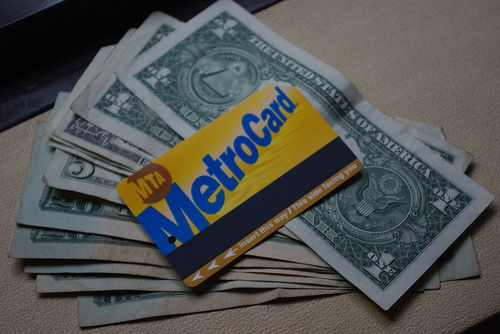
NEW YORK – Once again the Metropolitan Transportation Authority is threatening New Yorkers by making draconian cuts to bus and subway service, this time especially for students and seniors. One loses track of how many times the authority has done this over the past few years. While the MTA board usually backs down from the most horrific of its planned abuse of New Yorkers, each time there are at least some cuts, either fare increases or service reductions – or both.
This time is both similar to, and different from, the previous go-arounds. What is different is that the proposed service reductions are even worse than past “doomsday” scenarios. What is the same is that no cuts or fare increases are actually necessary.
Big cuts proposed
New Yorkers are already reeling from fare hikes and service cuts, but now the MTA wants to do more. In December the board voted to axe the W and Z trains, as well as 21 bus routes. They’ve agreed to cut the number of trains per hour on all the other lines. At night, trains are slotted to run only once every 30 minutes.
But perhaps most egregious of all is the treatment of students and seniors. Under the new rules, students will no longer get free or reduced fare Metrocards, meaning that New York will become one of the only cities in the country that doesn’t bother to give its students a way to get to school. This undermines the basic democratic right to an equal education for all (a right that has never been fully realized in this country, and, to the extent that it has been achieved at all, has been severely eroded over the past few decades).
Effects on young people
In this city’s school system, young people apply to high schools. That is, they try to get into the best high schools in the city, either a “flagship” school like Stuyvesant or the Bronx School of Science, or a school that specializes in a certain field. A lower-income student who excels at his or her coursework in predominantly African American East New York can apply to Stuyvesant, and, if accepted, receive a stellar education. The questions have to arise: Why can’t all of our city schools be as good as Stuyvesant? What about the fact that schools in poorer areas, where students are mainly racially and nationally oppressed, are invariably worse off economically than those in wealthier, whiter neighborhoods? Yes there is, at least, the possibility of applying to and getting into a top-notch school. But getting into a school means nothing if you can’t actually get there. Without the free Metrocards, that student in East New York, along with his or her family, will have to decide: Spend the money ($4.50 per day, $22.50 per week, about $90 per month) to get to Stuyvesant, or forego the opportunity and go to the local school. In an area where more than one in five people live in poverty, that extra $90 amounts to a significant monthly wage reduction and is simply impossible.
Unequal impact
This will affect all working people, but the racist dimensions cannot be ignored: African Americans and Latinos will be disproportionally affected. The same goes for seniors, who will have their Access-a-Ride service cut.
Currently, seniors can call Access-a-Ride and get picked up from their home and brought where they need to go. This system has been riddled with problems – talk to any city senior and listen to the stories of incredibly long wait times – but, once again, we have an “at least” situation: at least seniors were able to get around. Now, Access-a-Ride service will be trimmed, and our older residents will be picked up and brought only to the closest accessible subway station. Hopefully their destination subway station won’t be an inaccessible one (without an elevator or escalator)! Since most stations are non-accessible, areas around these stations will simply become no-go areas for our older population.
What kind of city treats its younger and older generations like this?
Solutions
The public has learned not to trust the MTA, a shadowy authority known for keeping at least two sets of books. But even if it is true that there is a $383 million deficit in the MTA’s budget, there are ways to fix the problem without these abominable cuts.
City Council’s plan
The newly elected City Council, more progressive than the old, has started a campaign against the cuts, and has put forward a realistic plan to alleviate a huge portion of the deficit. The plan is as follows:
• Reallocate 10 percent of direct stimulus aid to MTA operating expenses (this should generate about $91.5 million)
• Use budgeted PAYGO capital funds for operating ($50 million)
• Reallocate 10 percent of additional stimulus transit aid via state to operating expenses ($30 million).
This plan is, of course, not perfect. Allocating money away from the capital fund, which is used for new projects, such as the Second Avenue subway line, is harmful. It holds up important projects, and would stop the creation of jobs that such projects bring about. This is important, and can’t be overlooked. Nonetheless, the situation is extreme.
If the City Council plan is the best we can win for now, it has to be supported. But we New Yorkers should, while supporting that, be fighting for something more as well.
Giveaways to the rich
As the People’s World reported earlier, the MTA has made numerous sweetheart deals with developers, most notably around the Atlantic Yards project in Brooklyn (itself a miserable debacle pushed by Mayor Bloomberg). That project represents a giveaway of hundreds of millions of dollars to a private developer.
We should demand that this deal be canceled.
Why should some private business be given tens of millions to make hundreds of millions, while our brothers and sisters, especially the oldest and youngest, are made to suffer?
Put the burden on those who can afford it
We should demand that the Fair Share Tax, won only recently, not be allowed to sunset, and that it be increased. Instead of essentially taxing students’ families a huge percentage of their income by cutting the reduced-fare Metrocard, why not tax the wealthiest few, those who can afford it, directly? For the same reason, there should be another surcharge on the wealthiest New Yorkers.
The fight is not over. We have until June before these cuts are scheduled to go into effect. On our side is the City Council, tens of thousands of students who are organizing, a number of state senators and Assembly members, Transport Workers Union Local 100 (which itself would share a special pain if these cuts go through) – in short, the vast majority of New Yorkers.
We can stop these cuts and put the whole progressive movement in a better position. The question is how big of a victory we can achieve.
Photo: http://www.flickr.com/photos/renaissancechambara/ / CC BY 2.0












Comments